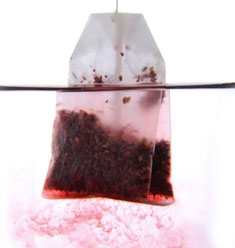Tea Time is Healthy Time
Common ingredient in most herbal teas lowers risk of heart disease
By Peter Bendix

“We found that three cups a day of hibiscus tea significantly lowered systolic blood pressure among the group of people who consumed the tea daily for six weeks,” says Diane McKay. Photo: iStockphoto
Tea time may be the healthiest time of the day. That’s because hibiscus, the most common ingredient found in blended herbal teas sold in the U.S., significantly lowers blood pressure, says Diane McKay, a scientist in the antioxidant lab at the Jean Mayer USDA Human Nutrition Research Center on Aging at Tufts.
McKay, who is also an assistant professor at the Friedman School, based her findings on a double-blind study involving people who were pre-hypertensive or who had mild hypertension and were not already taking medication to lower their blood pressure.
She presented her study results at an American Heart Association conference in New Orleans in November. “We found that three cups a day of hibiscus tea significantly lowered systolic blood pressure among the group of people who consumed the tea daily for six weeks, compared with a placebo beverage containing artificial hibiscus flavor and coloring,” she says. “And the effect was even greater among people who had a higher baseline level of systolic blood pressure.”
Herbal teas contain flavanoids, chemical compounds known for their antioxidant activity, says McKay. “The health benefits associated with consuming a diet rich in flavanoids include a lower risk of heart disease or cardiovascular disease, as well as a reduced risk for some cancers,” she says.
McKay should know—she’s done the research. She has conducted four separate studies on different kinds of herbal tea over the past three years, each of which has reinforced the health benefits of various types of tea, including rooibos, honeybush, chamomile and peppermint.
She cautions that some changes to the herbal tea, such as adding milk or sugar, may cause it to lose some of its health value, but not much. For example, adding sugar changes tea from a “healthy, calorie-free, flavanoid-rich beverage” to a sugary drink that, “if consumed in excess of your calorie needs, can contribute to obesity over the long run,” McKay says.
Additionally, fat contained in milk may actually lower the antioxidant power of tea. That’s because flavanoids in tea try to prevent the oxidation of the fats in the milk. High milk fat content means more flavanoids interacting with the fat and fewer available to help in the body. “So skim milk or low-fat milk would be preferable,” she says.
Iced tea is more diluted than hot tea, because of the extra water from melting ice cubes. To make up for the lost flavanoids, “you can simply brew stronger tea, either by letting the tea steep for a longer time or by adding an extra bag,” she says.
So the next time you brew a cup of your favorite herbal tea, remember that it’s not only delicious, but healthy, too.
Peter Bendix, A08, is an editorial assistant in Tufts’ Office of Publications. He can be reached at peter.bendix@tufts.edu.


